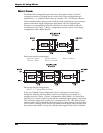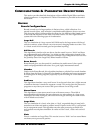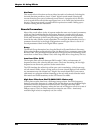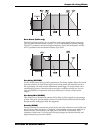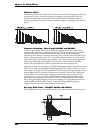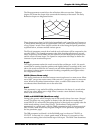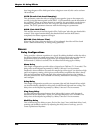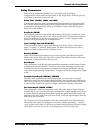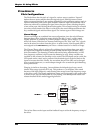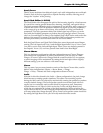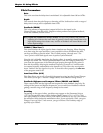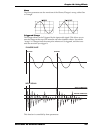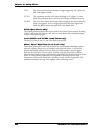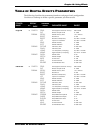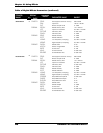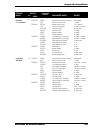
Chapter 10: Using Effects
222 ANDROMEDA A6 REFERENCE MANUAL
PITCH EFFECTS
Pitch Configurations
The Pitch effects alter the pitch of a signal in various ways to produce “layered”
timbres that are more complex than the original signal. Although some of these
effects can sound similar to one another depending on the parameter settings, each is
achieved differently and can be quite dramatic under the right circumstances. Pitch
effects are achieved by splitting the signal into at least two parts, affecting the pitch
of one of the parts, then mixing them back together. This eventual mixing is essential
since the overall sound of the effect is achieved by the actual difference between the
dry, uneffected signal and the effects signal. The various types of Pitch change are:
Chorus/Flange
Chorus and Flange are combined into one configuration, since the only difference
between these effects is the time range of delay the effect "scans", so they sound
slightly different. A predelay of 0-14 will produce a flanger, and a delay of 15 or
more will chorus. Note that on Choruses and Flangers, the “Wet” and “Dry” signals
need to be mixed in order to hear the effect—in other words, if the Program/Mix is
not assigned to the
MAIN OUTPUT, you'll hear a vibrato instead of a chorus or flange.
The Chorus/Flange effect is achieved by splitting the signal into three parts with a
dry signal and a separate Detuning section for both left and right channels, offset
from one another. The detuning is further effected by being modulated by an LFO
(low frequency oscillator) which causes the detuning to vary. Many variables are
available in this scheme: the Predelay can be varied, the LFO depth can be varied, the
LFO speed can be varied, and a portion of the detuned signal can be fed back to the
input to increase the effect. Finally, the waveform shape of the LFO can be changed
from a smooth sinewave, to a more abrupt triangle wave to make the pitch detuning
more pronounced.
Flanging is similar to chorusing , but modulates the delayed signal over a much
shorter delay range (typically 0-12 ms). This produces a “jet airplane”-like sound
because of the high-frequency comb filtering that sweeps across the frequency range
as the delay varies. The flange modulation sweep can be triggered by the audio input
in order to sync up with the rhythm of your playing. You can adjust the attack and
release threshold of this audio triggering function.
The A6 has filters on the input and the feedback loop to tailor the frequency sweep of
the effect.



